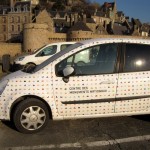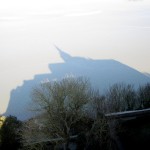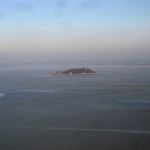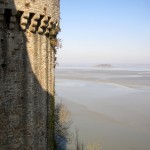The Monastery of Mont Saint-Michel is a mind-blowing mass of rock, iron, and concrete piled on an island mountain off the coast of Normandy. Around it sprawls an enchanted sand plane whose state depends entirely on the gaze of the moon. At high tide, the mountain is an island surrounded by the English channel and other rocky isles that dot the landscape. At low tide, the waters flee to the horizon leaving grey sands as far as can be seen.
Beneath its zenith where the golden guilt figure of the Archangel Michael overlooks this ancient Benedictine Abbey, there is a deep, rumbling hunger for tourists. Mont Saint-Michel slurps tourists from buses, snaps them up from cars; it devours them young and old, French and foreign; and it sucks them in from everywhere its hauntingly magical image can ensnare more prey. If my English hasn’t gotten too rusty over here, I think it’s what we call a tourist trap.
Any morsel of food purchased there is bound to be around 3 times the price of anywhere else, and where they find the idiots who pay to stay in the hotel on the island, I have no idea. Wrapped around the base of the mountain are souvenir shops, and overpriced eateries that take up more space than the Abbey itself. There are shirts with fancy writing and images, figurines both beautiful and kitschy, posters and postcards of the island (and some that have nothing to do with it), and in one shop there were Mont Saint-Michel special edition condoms. I found this last detail ironic, hilarious, and horrible.
Some people look down at places like this. There is a vein of hipsters in traveling culture that is repulsed by such “touristy” sites. (For those none-college students reading, hipsters are known for rejecting popular music, art, and life in favor of whatever is more obscure. They feel this makes them more unique, cultured, and sophisticated than those who like popular things.) Not only do hipsters reject tourism of most kinds, but everyone has a biased against tourism, as indicated by the face that none of us ever wants to be a tourist. There is a stigma about traveling to some place where thousands of over people go, camera in one hand and map in the other.
But the problem with avoiding popular tourist destinations is that sometimes, things are popular because they’re mind-blowingly, stupifyingly amazing. UNESCO has listed the Abbey and surrounding land as a world heritage site. This means that the site is considered an important part of the history, culture, and treasure of the world. Tourism produces huge crowds, kitschy gifts, and enough photos of some places to pinpoint the signs of again to the minute they appear. Sometimes, it can pose problems to natural resources such as snowmobiles which pollute Yellowstone National Park, something we discussed in Environmental Politics. Those are issues that must be taken into consideration, and the environment and site need to be preserved.
However, these are possible effects of tourism. I am concerned with the concept itself. At its heart, tourism means people participating in the open accessibility to some of the greatest treasures on Earth. Those millions of people trampling through the wonders of the world are millions that, in another time, would never have gotten to see such marvels. There will always be hipster travelers who would rather go to the 3 Garden Hoses and a Box of Jelly Bean Colored Spark Plugs Breakfast Pub in Whatchamanowhere Somecountry. But I am proud to be a tourist, because the tourist is a kind of democrat. By their nature, tourist destinations are not restricted to a select few who have unique access to the world’s treasure. Tourists come in droves because that’s the point: to let the people in.
- Is this truck driving in the ocean? No, just cleaning off the parking lot that’s about to emerge as the tide goes down.
- Oh look, the French monument-mobile.
- The shadow of Mont Saint-Michel
- The view towards the other little isles out towards the sea at high tide.
- Another view from Mont Saint-Michel




